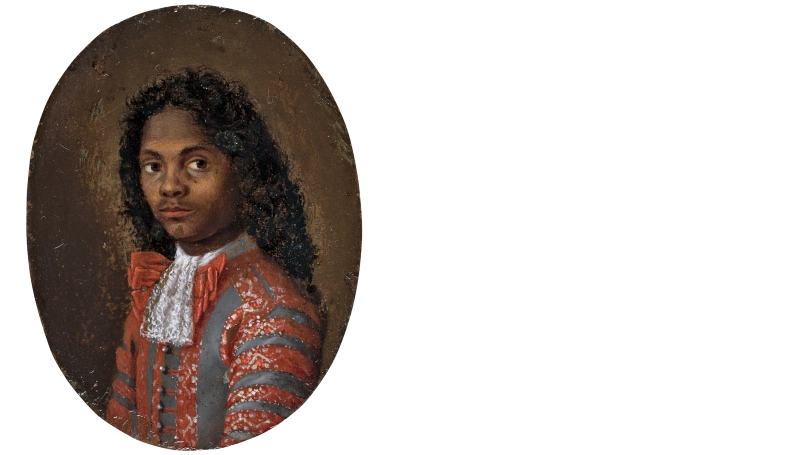ELIZABETH RICE MATTISON, Andrew W. Mellon Assistant Curator of Academic Programming
Hood Quarterly, spring 2022
This small painting represents an exceptional portrait of a man of African descent living in Europe in the seventeenth century. The man's elaborate aristocratic-style dress, elegant coif, and direct gaze mark his high status and suggest his place in a northern European court. Antwerp, where this portrait was painted, was a key international hub, at the crossroads of Atlantic exchange, Iberian rule, and northern European courts in the sixteenth and seventeenth centuries. This intimate portrayal, represented here to scale, speaks to the diplomatic and social exchanges between Europe and Africa in the early modern period.
While European painters often made character studies of people of African descent in fantastical garments, paintings called tronies, this portrait was completed from life. That this miniature is a portrait and not an imagined representation is indicated by the specificity of the man's face and his courtly, rather than exoticized, garments. Although archival evidence records the lives of pre-modern Black Europeans, images documenting their presence are today incredibly rare. Portraits of diplomats and traveling African rulers comprise the surviving representations from the sixteenth and seventeenth centuries. While the name of the portrait's sitter is currently unknown, he was possibly an African diplomat to the Spanish court based in the Southern Netherlands (present-day Belgium) in the 1670s. Many of these diplomats came from the Kingdom of Kongo, the powerful central African state with strong trading ties to Iberia and the Netherlands. Only about five comparable paintings of people of African descent remain from this period, almost all diplomatic portraits. Until the Hood Museum's recent acquisition, this painting was entirely unknown by scholars and represents significant evidence of the lives of people of color in northern Europe.
The high quality of this portrait demonstrates the authority that people of African descent could hold in seventeenth-century Europe. Choice of a prestigious medium, oil painted on copper, gives the portrait a gentle glow and further indicates the man's power. The sitter himself likely commissioned the portrait to give to one of his European contacts. Painted by Gonzales Coques (1614–1684), the court artist to the Spanish governor of the Southern Netherlands Juan Domingo de Zuñiga y Fonseca (1640–1716), the portrait exemplifies the artist's sensitive style. Coques was best known for his portrait miniatures of Antwerp's noble networks, an elite group that likely included this man. Even as this man could take part in courtly life in Antwerp, Europeans were increasing their colonization of African nations, their proselytizing mission, and their enslavement of Africans. Made to be held in the hand, such miniatures were collected to be viewed privately or in small groups. They were objects of prestige for the patron and the recipient. These diminutive paintings enabled intimate portrayals, while participating in important gift-giving practices that formalized personal, political, and social relationships. With his likeness sensitively rendered in oil, this man could forge intercontinental relationships by engaging in such traditions. This portrait materially captures the ongoing exchange between African and European courts, at a moment when hierarchies of race were in the midst of transition and definition.
Complementing the Hood Museum's collection of American portrait miniatures, this painting allows the museum to represent the diversity of people living in early modern Europe. With this miniature, the museum can tell a fuller story of race, power, and cross-cultural encounters.
